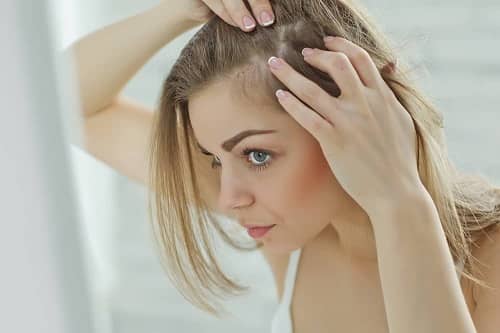Traction alopecia hair loss, if caught early, is reversible. It takes a while for hair to regrow, but it is almost always under the patient’s control. However, there can be circumstances where traction alopecia is a permanent concern that requires treatment with hair restoration surgery. Miami-based Dr. Jeffrey Epstein is a board-certified facial plastic surgeon and hair restoration specialist who performs natural-looking hair transplants for patients with permanent traction alopecia.
What Is Traction Alopecia?

Traction alopecia occurs when patients apply too much force on their hair or frequently pull it out in the same direction. It can be due to a tight hairstyle, curling irons, straighteners, or as a side effect of trichotillomania. Trichotillomania is a mental health disorder that compels a person to continuously pull at their hair follicles, causing them to weaken and the hair to fall out over time.
Fortunately, traction alopecia is different from other hair loss problems, such as the alopecia areata, an autoimmune disorder. Since traction alopecia is caused by manual manipulation, it depends on the patient to reverse its effects.
While traction alopecia is not a medical concern, it can be disheartening for patients to lose hair due to their daily habits. While many patients face temporary setbacks in hair growth, it can be a permanent complication for a few, leading to a need for hair transplant surgery.
Before looking for surgical procedures, it is best to know what traction alopecia looks like, understand its severity, and recognize if it has reached the stage for transplant.
What Does Traction Alopecia Look Like?
It’s not always easy to detect traction alopecia. At first, pimple-like bumps appear on the scalp. As time goes on, more hair might fall out, break off the roots, look strained, and become weaker.
The scalp will be the most affected area for steady hair loss. A receding hairline typically occurs around the forehead, nape, and temples. For some, the part might also widen over time.
As more time passes, patients may notice red patches on the scalp that are sore and produce a stinging sensation. The scalp might itch a lot and there can be inflammation and ulcers. There can also be pus-filled blisters over the scalp.
The scalp usually gets scarred and shiny in advanced cases. Damaged hair from this point will not be able to grow back and might lead to permanent traction alopecia.
Causes of Traction Alopecia
Many factors contribute to traction alopecia. These can include:
Hairstyles
A patient’s hairstyle can add a lot of pressure on the scalp, leading to traction alopecia. Tightly braided hairstyles such as cornrows, tightly-knitted braids, top buns, and high ponytails can weaken hair follicles. These styles put too much tension or stress on the hair follicle, weakening them from the roots.
Daily Headwear
Traction alopecia usually also results from certain types of headwear. If patients use tight helmets or elastic headbands on a regular basis, the follicles in contact with the gear can eventually thin out from friction.
Weaves and Extensions
A person might decide to get hair extensions to create a fuller or more voluminous look. However, gluing heavy weaves to hair can cause tension and weaken the roots.
Appliances and Accessories
Curling or straightening hair with appliances can damage the follicles in the long run, especially they are used frequently. The same goes for tight hair clips that may tear off the hair.
Chemical Treatments
Color dyes, perming, and other chemical treatments are dangerous for follicular health. While occasional treatments do not harm hair growth, monthly or weekly schedules can hurt the hair.
Temporary Vs. Permanent Traction Alopecia
A patient can either experience temporary or permanent alopecia. There is minimal damage to the hair follicles with temporary loss, and a few changes in hair care and styling habits can reverse this hair loss.
For example, if the patient ceases using tight hairstyle routines, reduces hair dye usage, and avoids hair appliances, their hair can typically grow back within a year. They can also opt for medications such as minoxidil or platelet-rich plasma therapy treatment. These help to encourage new hair growth.
If the patient has trichotillomania disorder and wants to treat it, they can consult with a mental health professional. By doing so, they can work toward managing the urge to pull out their hair.
Traction alopecia is most likely permanent if there is no hair growth for a year after changing habits. In these cases, hair restoration surgery can be helpful. During this procedure, the surgeon takes hair follicles from a donor area. The donor area can be on the sides or back of the scalp with an adequate amount of hair.
If there is not enough hair in the scalp donor area, the surgeon may be able to take hair from another area of the body. They then transplant it to the area of hair loss for a permanent restoration. It takes several months for new hair to regrow on those areas.
How Is Traction Alopecia Treated?
The initial treatment for traction alopecia is simple. The patient has to initiate some lifestyle changes to improve their hair health.
Changing to Looser Hairstyles
Many people follow some hairstyle routines that are rooted in their religious or cultural beliefs. In such cases, it can be hard to wear them differently. However, they can try to wear the hair a bit looser to let it stay comfortable and healthy.
For others, it is crucial to change their hairstyle to save their hair. Many tutorials can help to change up an existing favorite hairdo into something more comfortable.
Patients suffering from traction alopecia can improve their hairstyles to be gentler on their hair. Doing so can prevent breakage, stress on follicles and help healthy hair re-growth.
Opt for Better Hair Products
Many shampoos, conditioners, hair serums, and oils can have harmful additives that potentially damage hair. For those who are suffering from traction alopecia, doctors suggest reading the label and ingredients list carefully before buying hair products.
The best products to treat hair problems are:
- SLS-free
- Paraben-free
- Naturally hydrating
The same goes for hair dyes, as some products can contain untested chemicals which stunt hair growth and weaken the roots.
Change up Maintenance Weekly
Changing up hairstyles every week can help reduce strain on the same follicles all the time. Patients can change their hairstyles weekly and often wear them loose to let the follicles heal.
Ask About Steroid Cream
Traction alopecia causes itchy swelling over the scalp. Some doctors usually prescribe a steroid cream to reduce the irritation and soothe the inflammation.
Can a Hair Transplant Help With Alopecia?
Hair transplant procedures can help patients enjoy natural-looking hair after addressing their alopecia. It is a minimally invasive surgery involving the transplant of healthy hair follicles onto the scalp from another area to mimic patients’ original look.
Surgeons use hair transplant surgery to improve thin hairlines, improve scalp condition, and make patients feel more confident. Of course, they need to evaluate various candidacy factors before recommending the surgery. Skin type evaluation, allergies, hair growth history, and more play a crucial role in determining whether the patient is the right candidate for a hair transplant.
A hair transplant candidate should have proper healthy hair on their scalp for the transplant process. If not, the surgeon may be able to use hair from other areas of the body.
Learn More About Alopecia
Hair transplant surgery can help with permanent traction alopecia. Traction alopecia patients from Miami can book a consultation with Dr. Jeffrey Epstein to learn more about their condition and the surgical requirements.
Patients with a proper understanding of their hair problems can also take better preventive measures. Call (305) 666-1774 for a traction alopecia consultation in Miami.
